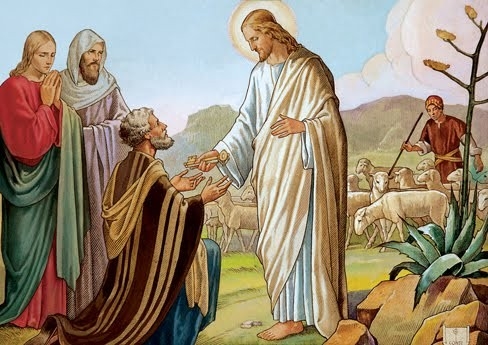FEBRUARY 22TH CATHEDRAL OF SAINT PETER APOSTLE
PRAYER
Grant, Almighty God, that among the upheavals of the world
do not disturb your Church, which you founded on the rock
with the profession of faith of the apostle Peter.
The chair of San Pietro (in Latin Cathedra Petri) is a wooden throne, which medieval legend identifies with the bishop's chair that belonged to St. Peter the Apostle as the first bishop of Rome and pope.
In reality, what is preserved is a 875th century artefact, donated in 1 by the Frankish king Charles the Bald to Pope John VIII on the occasion of his descent to Rome for his coronation as emperor. [XNUMX]
The throne of Charles the Bald then identified with the chair of San Pietro
It is preserved as a relic in the basilica of San Pietro in the Vatican, inside a grandiose Baroque composition designed by Gian Lorenzo Bernini and built between 1656 and 1665.
A copy of the wooden chair is also exhibited in the Historical Artistic Museum - Tesoro di San Pietro, with entrance from inside the basilica.
The name "cathedra" derives from the Latin term cathedra, which indicates the bishop's chair (the seat on which the bishop sits)
The feast of the chair of Saint Peter, inscribed on the general Roman calendar, dates back to the third century. [2] The Lexikon für Theologie und Kirche says that this feast originated in the celebratory meal of a dead man who was traditionally held in Rome on February 22 (Feralia), a celebration similar to the refrigerium that was used to be held in the catacombs. [3] [4]
The Filocalo Calendar of 354 and which originated in 311 indicates the only date of the feast on February 22. [5] Instead, in the Geronimian Martyrology, which in its present form is from the 18th century, two days of celebration dedicated to the chair of St. Peter the Apostle are indicated: January 22 and February 5. All the manuscripts of this document contain a late addition, according to which the February festival would celebrate the chair of St. Peter in Antioch, so the January festival was associated instead with the episcopal function of St. Peter in Rome and was treated as the most important. [XNUMX]
The feast of January was chosen in 1908 as the first day of the Octave of prayer for Christian unity, which concluded with the feast of the Conversion of Saint Paul on 25 January.
In the revision of the general Roman calendar made by Pope John XXIII in 1960, several feasts considered duplicates of others were abolished. In the case of the two feasts of the chair of Saint Peter, only the oldest one of February has been preserved. [6] Therefore even in the only form of the Tridentine mass now authorized as the "extraordinary form" of the Roman rite, that represented by the 1962 edition of the Roman Missal, only the feast of February remains. In any case, the Week of Prayer for Christian Unity continues to be celebrated on the same days in January, despite the abolition of the festival chosen as the initial day in the Roman calendar.
In the Ambrosian rite, however, the unified celebration is set for January 18, so as to distance it from Lent.
